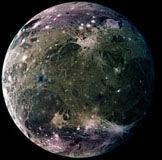





The third of Jupiter's large moons is Ganymede. It is the largest moon in the Solar System, being slightly larger than our Moon, Titan, and even the planet Mercury. It orbits between Europa and Callisto. It is a strange looking moon that appears to be undergoing some sort of transitional phase change from rock to ice, or ice to rock. The surface is cratered and rocky in places, but it also displays the icy characteristics of Europa in other regions of its surface. It is a jumble of areas and bands of rock and ice, transfixed in time. Unlike its two neighbors, there is no evidence of a sub-surface liquid ocean (though opinions may change as more data is collected). For the time being, Ganymede looks as though it is a static world devoid of life. The reason for this may be that the moon does not contain sufficient rock concentrated in a sufficient mass, for radioactive decay to generate heat to create liquid water. However some tidal heating must be taking place which is so limited it does not create enough heat to melt the ice at any depth within the moon.
For the present Ganymede is not arousing interest as a place where life might flourish.
© All images NASA
Go
to
Home
| Space Station
| Mars | Rainforest
© 1999 Satellite Events Enterprises Inc.